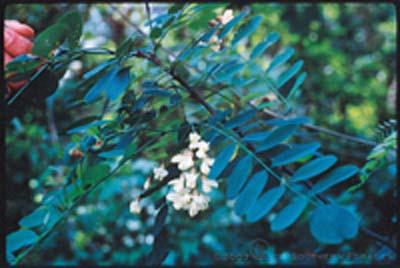
Black Locust (Robinia pseudoacacia)
Description: Small, thorny, leguminous tree with dark-colored rough bark and white flowers. Often, trees form a “thicket.” Individual trees rarely exceed a height of 50 feet.
Adaptation: Found throughout the South, especially in zones B, C, and D.
Poisonous Principle: Robinin (a phytotoxin) and robitin (a glycoside).
Symptoms of Poisoning: Weakness, nervousness, nausea, vomiting, diarrhea, bloody feces, posterior paralysis, and pounding heart-beat.
Other: All of the above-ground portions of the plant can cause poisoning, especially during the warmer months of the year. Horses are more sensitive than cattle, and the most commonly encountered problem results from horses chewing the bark of the trees. Usually not fatal.
© Southern Forages. International Plant Nutrition Institute
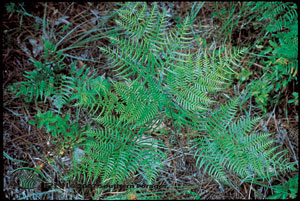
Bracken Fern (Pteridium aquilinum)
Description: Herbaceous fern, usually no more than 2 to 3 feet tall, and having stout, dark-colored underground roots. Spreads primarily by underground roots.
Adaptation: Widely adapted in the South and can be found in Zones A, B, C and D. Most common in the Coastal Plain, dry, or gravelly upland areas in the Piedmont or upper South.
Poisonous Principle: In monogastric animals, thiaminase (an enzyme) and possibly unidentified compounds. In ruminants, prolonged ingestion produces bone marrow suppression, possibly due to unidentified toxins.
Symptoms of Poisoning: In monogastric animals- weight loss, lethargy, convulsions, death. In ruminants- bloody feces, difficult breathing, failure of blood to clot, bleeding from all body openings, elevated temperature, death.
Other: The entire plant is toxic, either in green or dried form, but especially young green material. Death is more likely in cattle or horses than in sheep. Poisoning is most likely in late summer or autumn in years or situations in which little other feed is available. Symptoms may not appear for several weeks after consumption.
© Southern Forages. International Plant Nutrition Institute
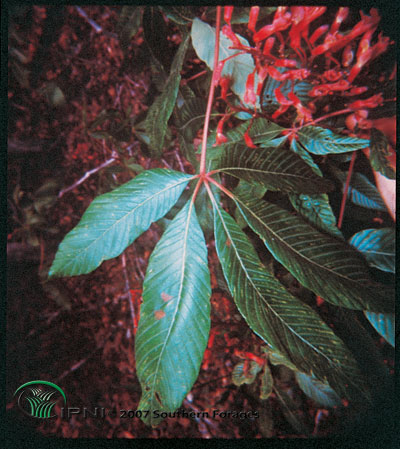
Buckeye or Horsechestnut (Aesculus species)
Description: Trees or shrubs, most having red, yellow, or yellow-green to white flowers and large (approximately 1 inch diameter) brown seeds or nuts.
Adaptation: Various species are adapted thoughout Zones A, B, C and D. Most commonly found along streams or the edges of woods.
Poisonous Principle: Aesculin (a glycoside) and possibly other unidentified agents.
Symptoms of Poisoning: Weakness, muscle spasms, vomiting, dilated pupils, paralysis.
Other: All types of livestock may be poisoned by eating young sprouts or tender leaves in the spring, or by consuming seed in autumn or early winter. Not likely to be fatal.
© Southern Forages. International Plant Nutrition Institute
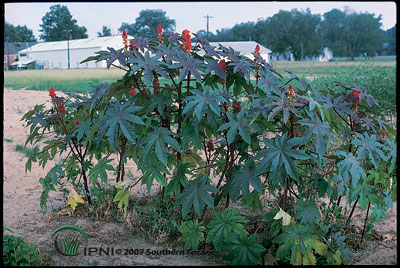
Castorbean or Mole Bean (Ricinus communis)
Description: Upright herbaceous summer annual with large leaves and reddish or purplish stems, sometimes reaching 12 feet in height.
Adaptation: Can be grown throughout Zones A, B, C, and D. Usually planted as an ornamental, but occasionally escapes and volunteers in old fields, waste places, or along roadsides.
Poisonous Principle: Ricin (a phytotoxin)
Symptoms of Poisoning: Vomiting, diarrhea, trembling, sweating, convulsions, and death.
Other: Both leaves and seeds can cause poisoning of all classes of livestock, but horses are particularly sensitive. Ricin is a deadly poison. Poisoning most frequently occurs as a result of grains or ground feed becoming contaminated with castorbean seed.
© Southern Forages. International Plant Nutrition Institute
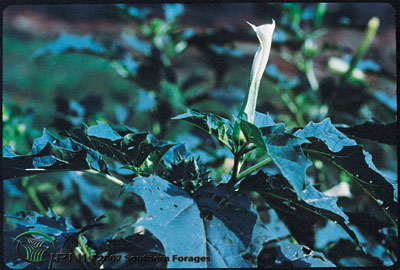
Jimsonweed or Thornapple (Datura stramonium)
Description: Herbaceous summer annual 3 to 5 feet tall with white or purplish flowers. The fruit is a spiny capsule 1 to 2 inches long.
Adaptation: Zones A, B, C, and D. A common weed in waste places, barnyards, disturbed areas, and cultivated fields, especially in the coastal plain.
Poisonous Principle: Hyoscyamine, atropine, and possibly other alkaloids.
Symptoms of Poisoning: Vomiting, dilated pupils, slow respiration, intense thirst, frequent urination, convulsions, and death.
Other: All parts of the plant are toxic, but especially the seeds. Dried plants mixed in hay can also be toxic. All types of livestock can be poisoned, but most cases occur with cattle. Poisoning by this plant can occur in summer or autumn when little other forage is available.
© Southern Forages. International Plant Nutrition Institute
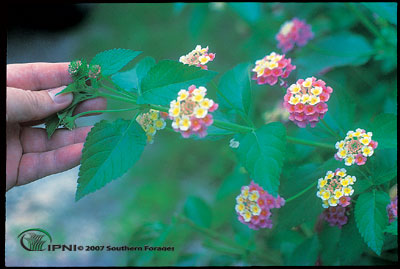
Lantana (Lantana camara)
Description: Herbaceous perennial shrub which may reach 5 feet in height. Flower color varies greatly.
Adaptation: Occurs wild in South Florida (lower portion of Zone A), but commonly grown as ornamental throughout the South. Occasionally escapes to roadsides and waste areas or may be present around old houses.
Poisonous Principle: Lantanin (a triterpenoid).
Symptoms of Poisoning: Vomiting, bloody and watery diarrhea, lesions around the mouth and nose, weight loss, death. Also causes photosensitization (tissue death and/or lesions), especially in light colored animals.
Other: All parts of the plant are poisonous, but especially the fruit. All types of grazing livestock can be affected. Usually not fatal.
© Southern Forages. International Plant Nutrition Institute
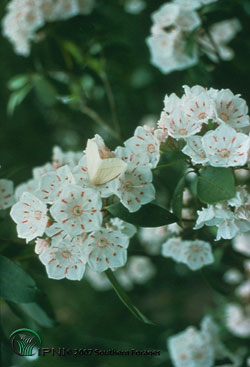
Ground Laurel, Ground Ivy, or Bush Ivy (Kalmia latifolia)
Description: Evergreen woody shrub or small tree with showy white, pinkish, or purplish flowers.
Adaptation: Usually in heavily wooded areas (often around spring heads and small streams) in the mountains or other woodlands in upper part of Zone B, and in Zones C and D.
Poisonous Principle: Andromedotoxin (a resinoid) and possibly other toxic compounds.
Symptoms of Poisoning: Excessive salivation, frequent swallowing, vomiting, frequent defecation, staggering, coma, death.
Other: All kinds of grazing livestock may be poisoned, but sheep seem to be particularly sensitive. Poisoning usually occurs in late autumn, winter, or early spring when little else is available for animals to eat. Otherwise, animals normally avoid the plant. Several related species in the genera may also be toxic. Goats are especially fond of ornamental azaleas.
© Southern Forages. International Plant Nutrition Institute
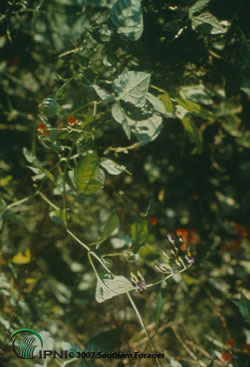
Nightshades (Solanum species)
Description: Annual or perennial herbs, some species covered with spines.
Adaptation: Various species are common in pastures, waste areas, or cultivated fields throughout Zones A, B, C, and D.
Poisonous Principle: Solanine and other alkaloids.
Symptoms of Poisoning: Excessive salivation, drowsiness, trembling, vomiting, diarrhea, dilation of pupils, paralysis, death.
Other: Poisonous or potentially poisonous species include deadly nightshade, horsenettle or bullnettle, and black nightshade. The leaves and especially the unripe fruit (berries) are poisonous to cattle, horses, and sheep. Apparently, numerous environmental factors, plant maturity, and possibly animal breeding influence susceptibility. In some cases animals have been known to selectively graze nightshades.
© Southern Forages. International Plant Nutrition Institute
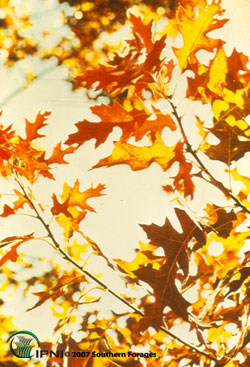
Oaks (Quercus species)
Description: Trees or woody shrubs, usually deciduous, the fruit or nut being an “acorn.”
Adaptation: There are many species of oaks, and there are numerous adapted species in Zones A, B, C, and D. Most species are best adapted to rich, well-drained soils.
Poisonous Principle: Tannins and possibly other unidentified compounds.
Symptoms of Poisoning: Constipation followed by bloody diarrhea, poor appetite, weakness, rough appearance, thirst and excessive urination.
Other: Poisoning of all types of livestock may result from consumption of leaves or acorns. Poisoning is unlikely unless there is little else for animals to eat, but once symptoms are observed death is likely even with treatment. Some of the most common species are white oak, Southern red oak, black oak, post oak, water oak, and blackjack oak.
© Southern Forages. International Plant Nutrition Institute

Oleander (Nerium oleander)
Description: Evergreen shrub or small tree with leathery leaves and reaching a height of up to 25 feet. Flowers white, yellow, pink, or red in clusters on stem tips.
Adaptation: Used as an ornamental primarily in the Coastal Plain (Zone A). May also be found around old buildings or growing wild in fencerows, along the edges of woods, or in waste places in some areas along the coast.
Poisonous Principle: Various glycosides and possibly other toxic compounds.
Symptoms of Poisoning: Vomiting, trembling, weakness, bloody diarrhea, death.
Other: Leaves and twigs can cause poisoning of all types of livestock. Poisoning usually occurs when animals have access to clippings. Dried or green foliage or other plant parts can be highly toxic. Smoke from burning plants can produce toxic symptoms.
© Southern Forages. International Plant Nutrition Institute
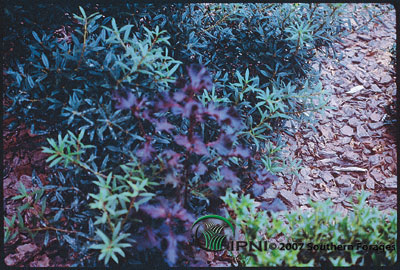
Perilla Mint (Perilla frutescens)
Description: Herbaceous annual with small whitish or purplish flowers and usually no more than 1 to 2 feet tall.
Adaptation: Common throughout Zones A, B, C, and D in pastures, waste places, and along roadsides.
Poisonous Principle: Unknown
Symptoms of Poisoning: Difficult breathing, nasal discharge, death.
Other: Apparently all above ground portions of the plant can be toxic. Poisoning is most common in cattle or horses, usually in late summer or autumn.
© Southern Forages. International Plant Nutrition Institute
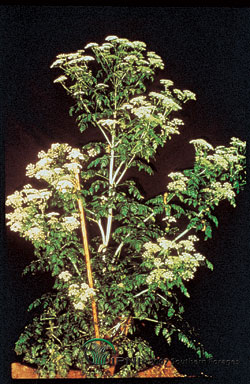
Poison Hemlock (Conium maculatum)
Description: Herbaceous warm season biennial resembling wild carrot. Stems hollow except at nodes. May reach a height of 6 to 8 feet.
Adaptation: May be found in wet-natured waste areas or ditches throughout Zones C and D.
Poisonous Principle: Several alkaloids, especially coniine and N-methyl coniine.
Symptoms of Poisoning: Bloody feces, vomiting, convulsions, paralysis, death.
Other: All portions of the plant are toxic. Toxicity increases as the plant matures, but decreases as it dries after being cut or frosted. If poisoning occurs, it is usually in the autumn. Grazing animals generally avoid it unless little other feed or forage is available.
© Southern Forages. International Plant Nutrition Institute
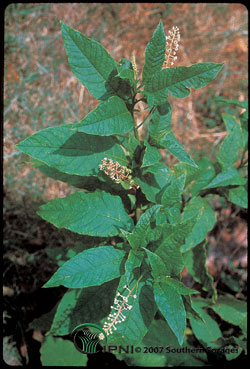
Pokeweed (Phytolacca americana)
Description: Upright perennial herb, reaching a height of up to 10 feet.
Adaptation: Common throughout Zones A, B, C, and D in waste areas, along roadsides, or adjacent to wooded areas.
Poisonous Principle: Phytolac-cotoxin (a saponin) and possibly other unidentified compounds.
Symptoms of Poisoning: Vomiting, convulsions, death.
Other: The leaves, berries, and especially the roots are toxic. Cattle and occasionally horses are poisoned, but poisoning is fairly rare. Poisoning most commonly occurs during hot, dry periods in summer and autumn. Cattle have reportedly aborted after eating this plant.
© Southern Forages. International Plant Nutrition Institute
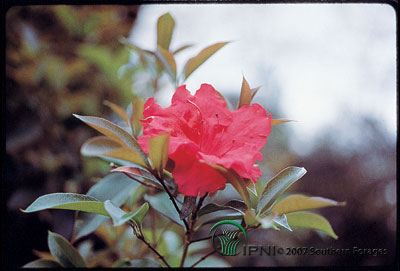
Rhododendron (Rhododendron species)
Description: Woody evergreen or deciduous shrub or small tree up to 15 feet tall. Flowers showy and may be white, rose, or pink.
Adaptation: Grows mainly at higher elevations in the mountains or the upper Piedmont in Zones C and D. Usually found in moist soils in heavily wooded areas.
Poisonous Principle: May contain at least two toxic compounds: andromedotoxin (a resinoid) and arbutin (a glucoside).
Symptoms of Poisoning: May include nausea, vomiting, incoordination, paralysis, and death.
Other: Flowers, leaves, and young stems may be toxic to cattle, sheep, or goats. Poisoning from plants in pastured areas usually occurs during winter or spring. However, due to the ornamental nature of the plants, trimmings or cuttings used for decorations can also be a source of toxicity. Related species in the genera may also be toxic.
© Southern Forages. International Plant Nutrition Institute
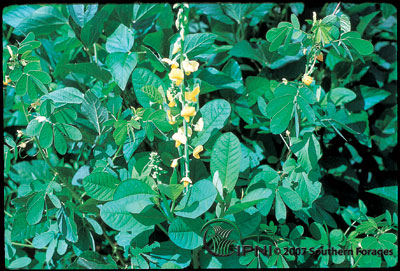
Showy Crotalaria (Crotalaria spectabilis)
Description: Herbaceous summer annual legume with bright yellow flowers, usually no more than 2 to 3 feet tall.
Adaptation: Widely adapted in the South, but most common in the Coastal Plain or dry upland areas in the Piedmont (Zones A and B).
Poisonous Principle: Monocrotaline (an alkaloid).
Symptoms of Poisoning: May be acute or chronic. Excessive salivation, nasal discharges, bloody feces, lethargy, weight loss, aimless walking, head pressing, death.
Other: All types of livestock can be poisoned by any portion of the plant. The seed are especially toxic. If mixed in hay, the dried plants and/ or seed can cause poisoning months after consumption. This plant produces very hard seed, and volunteer stands can occur when soil is disturbed after many years with no evidence of the plant. Several other species in the genus are also believed or known to be toxic.
© Southern Forages. International Plant Nutrition Institute
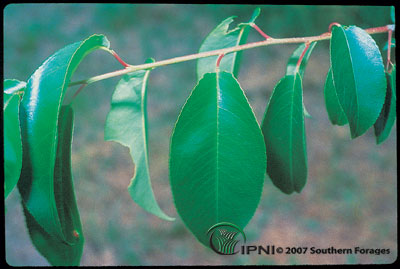
Wild Cherry or Wild Black Cherry (Prunus serotina)
Description: Woody shrubs or trees, usually small, with white or pink flowers. The fruit usually has a fleshy outer layer with a single hard stone in the center.
Adaptation: Commonly found in fencerows, borders of woods, and in waste places throughout Zones A, B, C, and D.
Poisonous Principle: Hydrocyanic (prussic) acid.
Symptoms of Poisoning: Labored breathing, spasms, rapid death. Low level poisoning may cause abortions.
Other: All types of grazing animals are susceptible. Many environmental factors may influence hydrocyanic acid levels, including drought and frost. However, most poisoning occurs when animals gain access to the wildted leaves of the plant recently cut or blown down. There are many related species in this genus which are also presumed potentially toxic, but wild black cherry is considered the most dangerous.
© Southern Forages. International Plant Nutrition Institute
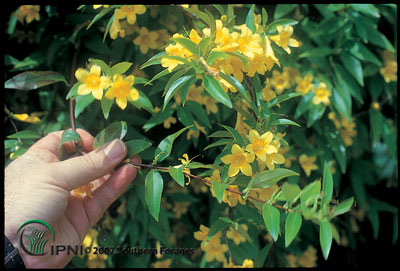
Yellow Jessamine or Carolina Jessamine (Gelsemium species)
Description: Perennial trailing woody vine with fragrant yellow flowers, vegetatively resembling honeysuckle.
Adaptation: Common in the Coastal Plain and Piedmont (Zones A and B). Usually found in thickets, along the edges of woods or stream banks, or in fencerows.
Poisonous Principle: Gelsemine, gelseminine, and gelsemoidine (alkaloids).
Symptoms of Poisoning: Weakness, slow breathing, dilation of pupils, convulsions, and death.
Other: All portions of the plant are toxic to all types of livestock. Poisoning normally occurs only in winter or early spring in situations in which little other forage is available and when large quantities are consumed.
© Southern Forages. International Plant Nutrition Institute
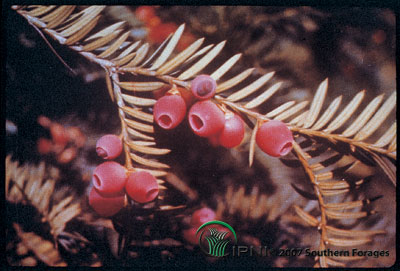
Yew (Taxus species)
Description: Evergreen shrubs or (usually) small trees having needle-type leaves, reddish-brown bark, and reddish or scarlet berries.
Adaptation: Found primarily at higher elevations in Zones C and D. Also commonly used as an ornamental.
Poisonous Principle: Taxine (an alkaloid)
Symptoms of Poisoning: Staggering, muscular incoordination, death.
Other: The bark, leaves, and seeds are poisonous to all types of livestock. Highly toxic but rarely eaten. Most poisoning occurs when cuttings are thrown into pastures or when plants in pastures are cut or blown down.
© Southern Forages. International Plant Nutrition Institute
